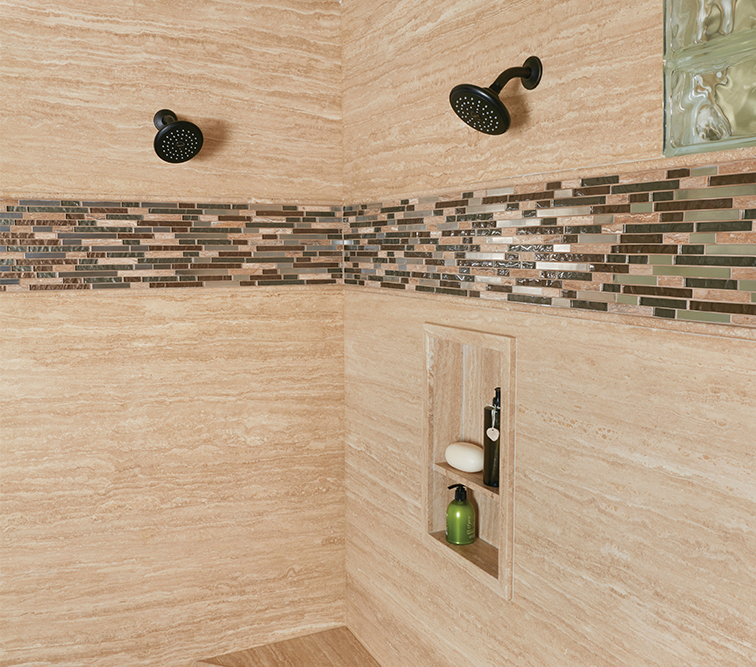Benefits & Drawbacks of Wet Room Bathroom Designs
Wet rooms have been trending the last few years and are popular in high-end bathrooms, thanks to their sleek use of materials and increased level of accessibility. These spaces do away with shower screens, trays, or barriers of any kind so that the room is totally opened up, and all surfaces are treated to be water-resistant. While a gorgeous wet room can certainly inspire instant bathroom envy, some homeowners may be concerned about the practicality of a room where everything has the potential to get soaked. Let’s take a look at some of the benefits and possible drawbacks of this trending bathroom style.
Benefit: Wet Rooms Offer a Taste of the High Life
Before they made their way into the home, wet rooms were first used in luxurious resorts as a way to treat guests to a lavish, all-encompassing bathing experience. In keeping with their origins, wet rooms usually have a slick, minimalist design and spacious layout that can make your bathroom feel like it’s straight out of a five-star hotel! Having such a high-end addition to your home will definitely increase its appeal to buyers, however, a word of advice: if you don’t plan on including a bath tub in your wet room, make sure that you have one elsewhere in your home. Real estate experts recommend having at least one tub to keep the property attractive to families.
Potential Drawback: Wet Rooms Are Possibly Pricey
As you may have already guessed, a wet room remodel typically costs a bit more than a traditional bathroom remodel. The price difference can range from just a few dollars more per square foot, to several thousand dollars more for the total project cost. The component that has the most impact on final price is the finish, with homeowners who choose to have their wet room tiled from top to bottom paying the most. For a more cost-effective option, consider using a different non-porous finish for some or all of the wall, such as our DuraBath material which is completely waterproof and mold/mildew resistant.
Benefit: It’s Convenient to Clean Wet Rooms
Let’s be honest: nobody enjoys cleaning the bathroom, so the faster it can be done, the better. Since wet rooms have fewer fittings and fixtures than a traditional bathroom, there are fewer places for filth to hide, making them much easier to clean. Simply mop the floor and wipe down surfaces, and you’re finished! You might also consider choosing a wall-hung toilet and a floating sink to keep the floor completely free from obstacles and clutter. If you have children, a wet room also means that they can splish-splash to their heart’s content during bath time without you having to worry about what’s getting wet.
Potential Drawback: Wet Rooms Have Space Constraints
Wet room remodels are most popular in roomy bathrooms, such as the master bath, as they give homeowners maximum design freedom, and the spaciousness contributes to the luxury of the room. However, with a little creativity, it’s still possible to turn a small or medium-sized bathroom into a wet room. Think about what can be eliminated or altered to free up space. Can the bathtub be removed? What about built-in or recessed storage? More wall-mounted fixtures? By carefully planning with a design consultant, you can create a functional, practical, and visually appealing wet room that fits your unique vision.
Benefit: Wet Rooms Offer Better Accessibility
At a time when 87% of adults age 65+ want to stay in their current home as they grow older, upgrading to a more accessible bathroom is a smart investment. Wet rooms have no curb, door track, or barrier to entry when bathing, so they’re more accessible to those who use mobility aids, such as a walker or wheelchair. Plus, if you opt for slip-resistant flooring such as our patented DuraGard technology, you’ll have peace of mind knowing that everyone who uses your bathroom is sure-footed and safe. If you choose to stay put, your new bathroom will suit your needs as you age, and if you choose to sell your home, the accessibility aspect will make it more appealing to potential buyers.
Potential Drawback: Wet Rooms Have Excess Moisture
Although the name “wet room” says it all, some homeowners don’t plan for how they’ll handle the additional moisture until it’s too late. Nonwaterproofed items such as towels and toilet paper must be situated so that they’re clear of any potential splash back from the shower. And without any kind of barrier to hold steam in, wet rooms can be damp and humid after a shower. To protect moisture-sensitive items (makeup, medicine, electronics, etc.) consider a smart storage solution such as covered basket shelves or a stylish contemporary vanity. You might also think about installing an extractor fan to remove unwanted moisture as quickly as possible. If you’re concerned about getting water everywhere, you can also elect to include a dry zone. A glass panel can effectively separate the two zones without breaking up the visual flow of the space.
Our verdict: wet rooms aren’t just a silly fad, and they can improve both design and functionality for homeowners looking for an elegant bathroom upgrade. However, it’s important to think through any potential obstacles or complications before you decide to execute your remodel. If you still have questions about wet rooms or just want to determine the best style for your next bathroom remodel, schedule a free in-home consultation now to meet with one of our design consultants
